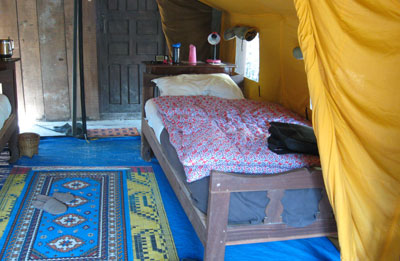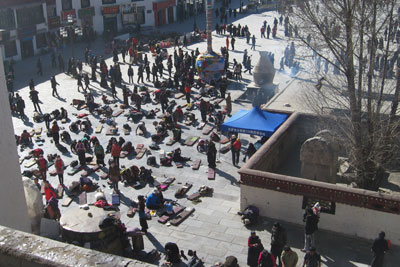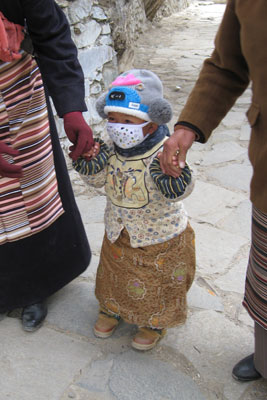Great views, cold rooms — Himalayas in winter with OAT
This item appears on page 25 of the October 2013 issue.
I was very pleased with the trip “NEPAL and the Mystical Himalayas” that I took with Overseas Adventure Travel (Cambridge, MA; 800/955-1925), my 11th trip with OAT. In addition to the 15-day tour, itself ($3,895), I took the 8-day pre-trip to BHUTAN ($2,395) and the 8-day post-trip to TIBET, China ($2,595). I had single accommodations throughout, with no single supplement charged.
I let OAT book my flights. Going from Richmond, Virginia, to Newark, New Jersey, and then on to Delhi, India, and back in coach class cost $1,430, but I upgraded to business class for an extra $3,900. Everything totaled up to $14,215 — expensive but a once-in-a-lifetime trip, for me. It began Jan. 2 and ended Feb. 1, 2013.
It was certainly the hardest trip I ever was on, in terms of physical challenges, and it was the longest time away from my husband, who couldn’t join me because the high altitudes aren’t good for his blood pressure. I had spent a year and a half taking fitness classes and walking, so I was in the best shape this 68-year-old body could manage.
OAT sent a booklet preparing us for what to expect. In at least three places it said, “You must be able to walk for four to five hours, unassisted, over the course of each day, exploring on foot for an average of two hours at a time, and standing for up to half an hour at a time. You must be comfortable paddling during our river float trip and participating in four to six hours of daily physical activities, sometimes at elevations above 5,000 feet.”
Still, there were two or three people on the trip who didn’t read the booklet or hadn’t believed it.
The OAT booklet was written really for summer travel, with very little in the way of winter-weather information. It should have emphasized that in Bhutan, somewhat, and Tibet, absolutely, there is no heat in houses, restaurants, banks, shops and hotel lobbies.
I’m from Maine and think that, of course, we know what cold is. But at home we can always go indoors to get warm. Not so in Bhutan or Tibet! Other than the hotel rooms, which often had only dog-breath-strength heaters, there was no place a person could go to get away from the cold. That kind of wears on a body after a week or so.
Here’s an assessment of our accommodations.
• Jumolhari Hotel (Norzim Lam, Thimphu, BHUTAN), Jan. 4-5. Nice hotel in good location. Shops close by. Desk staff very helpful and friendly and spoke English. Its “business center” was much more costly than the Internet café across the street.
Rooms clean and pleasant. Dogs in the streets barked all night and slept all day (true wherever we went in Bhutan). Hotel’s restaurant quite cold but served very good Bhutanese food (chicken, potatoes, veggies, flat bread, lentil stew).
• Two nights at Meri Puensum Resort (Woolakha, Punakha, Bhutan). Huge, clean rooms in many buildings on a steep hill on city outskirts. Some rooms had balconies over the valley and river.
Would be a perfect place in summer, as the grounds and views were beautiful, but rooms had inadequate heating, and wind blew around window panes and under doors. Resort owns only four hot-water bottles, so ask for one early. Bathrooms big. Lots of hot water.
No heat in the restaurant. Food very good. Hotel staff helpful; many spoke English.
• Kyichu Resort (Lamgong, Paro, Bhutan) was beautiful. Rooms in many circular stone buildings in beautifully landscaped grounds along a river.
Each lovely, clean room included a bedroom, sitting room and bath. Heating was inadequate, but the beds had heated mattress pads, and water in the bathroom was near-boiling.
Food good. Staff friendly, helpful. Some English spoken.
• The most memorable part of my Bhutan experience was when our guide, Tashi Dorji, took us to his family’s farm and home. He showed us where his Mom cooked, where the family prayed, even where he slept. To put himself in such a vulnerable position so that we could better understand life in Bhutan was beyond what he had to do, beyond my expectations. This made a very great impression on me.
• We had spectacular views of Mt. Everest to and from Bhutan aboard Drukair, aka Royal Bhutan Airlines. The plane was clean, with comfortable seating, very good food and pleasant flight attendants. (There is no good reason to take the special 200-dollar flight from Kathmandu to see Mt. Everest. We got to see it and all its buddies four times while flying between Bhutan, Nepal and Tibet.)
• Gokarna Forest Resort (Rajnikung, Gokarna, Thali, Kathmandu, NEPAL), on city outskirts, Jan. 10-12 & 22. A wonderful place, though the public areas weren’t heated. The grounds were lovely. Staff friendly, helpful; spoke English.
Our huge, very clean rooms had enormous bathrooms, heated mattress pads and hot water. Each had a TV, hair dryer and coffeepot. You had to shut your door tightly, as monkeys could sneak in and trash everything.
A huge breakfast buffet had Western and Asian offerings, including pastries, fruit, yogurts, and eggs to order — everything very yummy. The restaurant had very good food (tomato soup and bread, $4). In the full-service bar, a glass of wine cost $6 and a gin and tonic, $6.50.
There was a shop with lots of clothing and jewelry. The business center (unheated) with computers charged about $2.50 per hour.
• We flew to Pokhara and ate at what once was a popular hippy hangout in the ’70s, Moondance Restaurant & Bar (Pokhara, Nepal), along the main drag in Lakeside. New management in 1991 upgraded the place. It still had a relaxed vibe, but the food was quite “upmarket,” with Nepali, Chinese and Western dishes. Full bar and live music.
• The most memorable part of my Nepal experience was the 4-hour walk to the Sanctuary Lodge (Pokhara Valley, Nepal). It was a sunny, clear day, and Fishtail Mountain was brilliantly lit.
An easier walk along a dirt road was still quite a walk. I took the more challenging mountain path with most of the others. We could go at our own pace, but it was steep in places and rocky underfoot, with heart-stopping drop-offs on one side.
It also was quiet, with just birds and breezes making noise. The views across the valley, down to the river and out to the snow-covered mountains were spectacular. It was exactly what I had expected from descriptions of the trip and exactly what I spent a year training for.
At trek’s end, the lodge, where we stayed three nights, had rooms strung out motel style in a curve around a lovely lawn with views of Fishtail and other snowy mountains.
The rooms were adequate, clean and unheated. A hot-water bottle slipped into my bed each night became my best friend. There was hot water, evenings, but showering was still an act of courage, since the room was so cold. Through very thin walls, I could hear the folks next door turn pages in a book or roll over in bed.
Food in the restaurant was very good. Mixed drinks, killer strong, cost only $5.
Most of the staff, very helpful and friendly, spoke English. There was free laundry service employing ladies from the village.
• Back in Pokhara, we had two nights at Waterfront Resort Hotel (Lakeside Rd., Phewa Lake, Pokhara), a modern, clean facility with heat in good-sized rooms, many with balconies. Constant hot water in bathroom. Good food in the restaurant. Full bar. Friendly, helpful, English-speaking staff. Free use of two Internet-connected laptops.
• Two nights at the permanent tented Seti River Camp along the river. Big, walled tents each had a roofed wooden shelter overhead plus rugs on floors, real beds, electricity and a structure out the back with a flush toilet, sink and shower. Shower water was solar heated so best used in evening. Hot-water bottle each night. Coffee, tea or hot chocolate delivered each morning.
Very good Nepalese food. Strong bar drinks. Free laundry service.
• We stayed at Shangbala Hotel (1 Danjielin Rd., Lhasa, TIBET, CHINA), near Barkhor Square, Jan. 24-26, and it was terrible. No heat in the lobby, halls or breakfast room and very little in the guest rooms. Water often only lukewarm. Rooms not always serviced. Severely understaffed. Some English spoken.
• Great Tibetan and Chinese food at Lhasa Kitchen (Tibetan Hospital Rd., Lhasa), just off Barkhor Square. (From the front of the restaurant, the Jokhang Temple is at 2 o’clock.) Well worth the climb up to its second-floor location.
The staff spoke only Tibetan or Chinese, but the menu had pictures. They had dumplings, both steamed and deep-fried (but not greasy). Many dishes used yak meat. There were many vegetarian choices and lots of comforting noodle dishes. We ate there several times.
• Yeti Hotel (No. 11 Wei Guo Lu, Gyantse, Tibet, China) was nice, clean and quiet, with minimal heat but plenty of hot water. Room pleasant and bed comfortable. Good breakfast in freezing-cold lobby. Very helpful staff, but no English spoken.
• For our last night in Tibet, the group called OAT and threatened to mutiny if we weren’t put into a heated place! We switched to the 52-room Kyichu Hotel (Beijing East Road 149, Lhasa, Tibet, China), the perfect peace offering, with a pleasant courtyard. Rooms clean and quiet, with radiant heat in the floors and hot water 24 hours a day. Good breakfast.
• The most memorable part of my Tibet experience had to do with our being there in winter. Farmers making pilgrimages to the big temples and monasteries go then, since they can’t farm in winter. For some, it’s a once-in-a-lifetime trip. Some walk for days just to catch a long-distance bus to the cities.
They crowd the temples and holy places to light yak-butter lamps, spin prayer wheels and prostrate themselves in front of temples or up the steps. It was truly moving to see pilgrims of all ages waiting in lines at temples, praying out loud or quietly to themselves — so colorful.
They greeted us, seemingly the only Western people in the city, warmly, and stared at us and our clothes as closely as we stared at them and theirs. In some cases, I thought we might have been the first non-Tibetan or non-Chinese people they’d ever seen, so remote were the villages from which they’d traveled.
FLORENCE DRAKE
Readfield, ME



